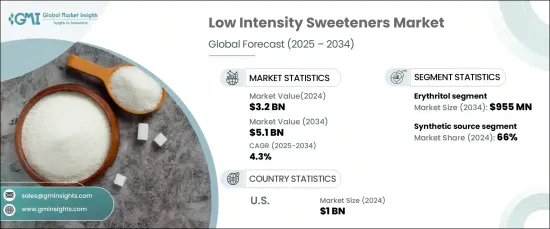PUBLISHER: Global Market Insights Inc. | PRODUCT CODE: 1667096

PUBLISHER: Global Market Insights Inc. | PRODUCT CODE: 1667096
Low Intensity Sweeteners Market Opportunity, Growth Drivers, Industry Trend Analysis, and Forecast 2025 - 2034
The Global Low Intensity Sweeteners Market achieved a valuation of USD 3.2 billion in 2024 and is poised to grow at a CAGR of 4.3% from 2025 to 2034. This steady growth reflects increasing consumer awareness about the adverse effects of excessive sugar consumption, particularly the rising prevalence of health conditions like diabetes and obesity. The food and beverage industry is witnessing a robust demand for sugar-reduced and calorie-conscious products, fueled by evolving health trends and government-backed initiatives promoting sugar reduction. Additionally, the increasing preference for clean-label and plant-based sweeteners is driving innovation, offering significant potential for market expansion.

Manufacturers are responding to consumer demand by focusing on improving taste profiles, scalability, and overall product quality. Advances in production processes and the introduction of novel sweeteners that cater to dietary requirements, such as those in diabetic-friendly and weight-management products, are further propelling market growth. However, the market faces challenges, including regulatory constraints and limited awareness in emerging regions. Despite these hurdles, the growing inclination toward sustainable and health-oriented alternatives positions the market for strong growth over the next decade.
| Market Scope | |
|---|---|
| Start Year | 2024 |
| Forecast Year | 2025-2034 |
| Start Value | $3.2 Billion |
| Forecast Value | $5.1 Billion |
| CAGR | 4.3% |
The market is segmented by product type into erythritol, maltitol, xylitol, d-tagatose, sorbitol, mannitol, allulose, and others. Among these, erythritol stood out as a dominant segment, recording USD 606 million in 2024, with projections to reach USD 955 million by 2034. Erythritol's widespread appeal stems from its natural origin, ability to replicate sugar's taste without influencing blood sugar levels, and digestive-friendly properties. Its increasing adoption among health-conscious consumers underscores its role in shaping the market's trajectory.
By source, the market is categorized into natural and synthetic segments. Synthetic low-intensity sweeteners accounted for 66% of the market share in 2024, driven by their cost efficiency and consistency in large-scale production. Their extensive use in processed foods and beverages aligns with the growing demand for calorie-conscious formulations that meet modern dietary preferences.
The United States emerged as a key contributor to the global market, generating USD 1 billion in 2024. The growing awareness of the health risks linked to high-calorie sweeteners has led American consumers to actively seek alternatives that provide sweetness without compromising health. This shift is particularly relevant given the rising incidence of obesity and diabetes in the region.
As consumer demand continues to align with health-forward and innovative solutions, the low-intensity sweeteners market is well-positioned for long-term growth and diversification.
Table of Contents
Chapter 1 Methodology & Scope
- 1.1 Market scope & definition
- 1.2 Base estimates & calculations
- 1.3 Forecast calculation
- 1.4 Data sources
- 1.4.1 Primary
- 1.4.2 Secondary
- 1.4.2.1 Paid sources
- 1.4.2.2 Public sources
Chapter 2 Executive Summary
- 2.1 Industry synopsis, 2021-2034
Chapter 3 Industry Insights
- 3.1 Industry ecosystem analysis
- 3.1.1 Factor affecting the value chain
- 3.1.2 Profit margin analysis
- 3.1.3 Disruptions
- 3.1.4 Future outlook
- 3.1.5 Manufacturers
- 3.1.6 Distributors
- 3.2 Supplier landscape
- 3.3 Profit margin analysis
- 3.4 Key news & initiatives
- 3.5 Regulatory landscape
- 3.6 Impact forces
- 3.6.1 Growth drivers
- 3.6.1.1 Increasing consumer demand for healthier alternatives
- 3.6.1.2 Government regulations promoting sugar reduction
- 3.6.1.3 Rising awareness of low-glycemic index sweeteners
- 3.6.2 Industry pitfalls & challenges
- 3.6.2.1 Potential issues related to aftertaste
- 3.6.2.2 Constant scrutiny and evolving regulations regarding the safety and use of sweeteners in food
- 3.6.1 Growth drivers
- 3.7 Growth potential analysis
- 3.8 Porter’s analysis
- 3.9 PESTEL analysis
Chapter 4 Competitive Landscape, 2024
- 4.1 Introduction
- 4.2 Company market share analysis
- 4.3 Competitive positioning matrix
- 4.4 Strategic outlook matrix
Chapter 5 Market Size and Forecast, By Product Type, 2021-2034 (USD Billion) (Kilo Tons)
- 5.1 Key trends
- 5.2 Erythritol
- 5.3 Maltitol
- 5.4 Xylitol
- 5.5 DTagatose
- 5.6 Sorbitol
- 5.7 Mannitol
- 5.8 Allulose
- 5.9 Others
Chapter 6 Market Size and Forecast, By Source, 2021-2034 (USD Billion) (Kilo Tons)
- 6.1 Key trends
- 6.2 Natural
- 6.3 Synthetic
Chapter 7 Market Size and Forecast, By Application, 2021-2034 (USD Billion) (Kilo Tons)
- 7.1 Key trends
- 7.2 Food & beverages
- 7.3 Pharmaceuticals
- 7.4 Personal care
- 7.5 Others
Chapter 8 Market Size and Forecast, By Region, 2021-2034 (USD Billion) (Kilo Tons)
- 8.1 Key trends
- 8.2 North America
- 8.2.1 U.S.
- 8.2.2 Canada
- 8.3 Europe
- 8.3.1 UK
- 8.3.2 Germany
- 8.3.3 France
- 8.3.4 Italy
- 8.3.5 Spain
- 8.3.6 Russia
- 8.4 Asia Pacific
- 8.4.1 China
- 8.4.2 India
- 8.4.3 Japan
- 8.4.4 South Korea
- 8.4.5 Australia
- 8.5 Latin America
- 8.5.1 Brazil
- 8.5.2 Mexico
- 8.6 MEA
- 8.6.1 South Africa
- 8.6.2 Saudi Arabia
- 8.6.3 UAE
Chapter 9 Company Profiles
- 9.1 Archer Daniels Midland
- 9.2 Cargill
- 9.3 GLG Life Tech
- 9.4 Hill Pharmaceutical
- 9.5 Ingredion
- 9.6 Madhava Natural Sweeteners
- 9.7 Merisant
- 9.8 Monk Fruit
- 9.9 PureCircle
- 9.10 Roquette Frères
- 9.11 S&W Seed Company
- 9.12 Stevia
- 9.13 Sunwin Stevia




